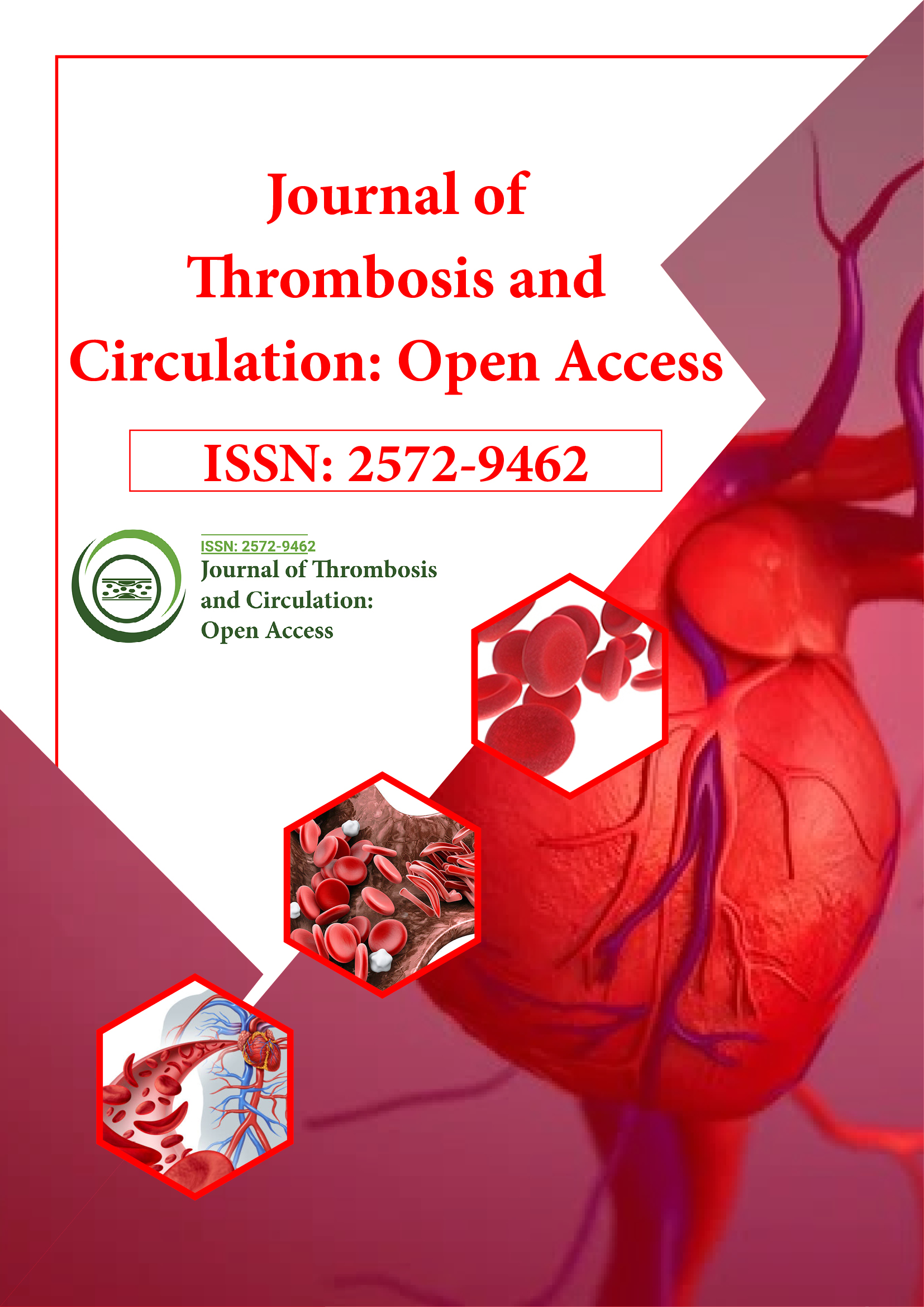Indexed In
- RefSeek
- Hamdard University
- EBSCO A-Z
- Publons
- Google Scholar
Useful Links
Share This Page
Journal Flyer

Open Access Journals
- Agri and Aquaculture
- Biochemistry
- Bioinformatics & Systems Biology
- Business & Management
- Chemistry
- Clinical Sciences
- Engineering
- Food & Nutrition
- General Science
- Genetics & Molecular Biology
- Immunology & Microbiology
- Medical Sciences
- Neuroscience & Psychology
- Nursing & Health Care
- Pharmaceutical Sciences
Opinion Article - (2025) Volume 11, Issue 2
Obesity and Thrombosis: Mechanistic Insights and Implications for Risk Management
Ananya Rajput*Received: 30-May-2025, Manuscript No. JTCOA-25-29343; Editor assigned: 02-Jun-2025, Pre QC No. JTCOA-25-29343 (PQ); Reviewed: 16-Jun-2025, QC No. JTCOA-25-29343; Revised: 23-Jun-2025, Manuscript No. JTCOA-25-29343 (R); Published: 30-Jun-2025, DOI: 10.35248/2572-9462.25.11.308
Description
Obesity is a global epidemic and a well-established risk factor for cardiovascular disease. In recent decades, a growing body of evidence has linked obesity with an increased risk of both arterial and venous thromboembolic events. This association is not solely attributable to comorbidities such as hypertension, diabetes and dyslipidemia; rather, obesity itself induces a prothrombotic state through complex metabolic, inflammatory and hemostatic changes. Understanding these pathophysiological mechanisms is essential for developing effective prevention and treatment strategies targeting thrombotic disease in obese individuals.
One of the hallmark features of obesity is chronic low-grade inflammation, primarily driven by dysfunctional adipose tissue. Adipocytes and infiltrating macrophages secrete proinflammatory cytokines such as Interleukin-6 (IL-6), Tumor Necrosis Factor-Alpha (TNF-α) and Monocyte Chemoattractant Protein-1 (MCP-1), which upregulate hepatic synthesis of clotting factors including fibrinogen, factor VII and Plasminogen Activator Inhibitor-1 (PAI-1). Elevated PAI-1 impairs fibrinolysis, promoting clot persistence and increasing susceptibility to thrombosis.
In addition to inflammation, adipose tissue secretes adipokines like leptin and adiponectin, which exert opposing effects on vascular biology. Leptin enhances platelet aggregation and oxidative stress, while reduced adiponectin levels commonly seen in obesity are associated with endothelial dysfunction and increased vascular inflammation. These changes collectively disrupt endothelial homeostasis, shifting the balance toward thrombosis.
Hypercoagulability in obese individuals is further exacerbated by increased levels of tissue factor, Von Willebrand Factor (vWF) and thrombin-antithrombin complexes, all of which contribute to heightened thrombin generation. Moreover, obesity is associated with platelet hyperreactivity and impaired nitric oxide signaling, amplifying platelet-driven thrombus formation, especially in arterial beds. These mechanisms help explain the increased incidence of myocardial infarction and ischemic stroke among obese individuals, independent of traditional cardiovascular risk factors.
Venous Thromboembolism (VTE) is also strongly associated with obesity. Epidemiologic studies consistently demonstrate that obese individuals have a two- to threefold higher risk of deep vein thrombosis and pulmonary embolism compared to those of normal weight. Several factors contribute to this risk, including increased intra-abdominal pressure leading to venous stasis, immobility and impaired venous return. Central obesity appears to confer greater thrombotic risk than peripheral adiposity, emphasizing the role of visceral fat in systemic inflammation and coagulopathy.
Obesity also complicates the clinical management of thrombosis. Diagnostic imaging may be technically challenging due to body habitus and pharmacologic therapy requires careful adjustment. Dosing of anticoagulants, particularly low molecular weight heparin and Direct Oral Anticoagulants (DOACs), must consider body weight and renal function to ensure therapeutic efficacy without increasing bleeding risk. Despite these complexities, DOACs have demonstrated safety and efficacy in obese populations, although data in morbid obesity (BMI ≥ 40 kg/m2) remain limited.
Weight loss is a critical component of thrombotic risk reduction in obese individuals. Both lifestyle interventions and bariatric surgery have been associated with improvements in endothelial function, reductions in inflammatory markers and normalization of coagulation profiles. Studies have shown that significant weight reduction leads to decreased PAI-1 levels, enhanced fibrinolysis and reduced thrombotic events. The metabolic improvements following bariatric surgery such as resolution of insulin resistance and dyslipidemia further support its role in cardiovascular risk mitigation.
Pharmacologic agents used in obesity management, including GLP-1 receptor agonists, have shown promising cardiovascular benefits. These drugs not only promote weight loss but also exert anti-inflammatory and antithrombotic effects, potentially lowering the incidence of both arterial and venous thrombosis. Their integration into obesity treatment regimens may offer dual benefits in reducing weight and thrombotic complications.
Risk stratification tools should incorporate obesity as an independent variable. While obesity is included in some VTE prediction scores, it is often underrepresented in arterial thrombotic risk models. Incorporating biomarkers such as D-dimer, hsCRP and PAI-1 levels may enhance risk prediction and guide prophylactic strategies. Special consideration should be given to obese patients undergoing surgery, hospitalization, or long-haul travel, as these periods of immobility substantially increase thrombotic risk.
In summary, obesity promotes a hypercoagulable and proinflammatory state that predisposes individuals to both arterial and venous thrombosis. Through complex interactions involving adipokines, cytokines, endothelial dysfunction and altered coagulation pathways, excess adiposity contributes significantly to vascular disease burden. Effective thrombosis prevention in obese patients requires a multifaceted approach combining lifestyle modification, weight management, pharmacologic therapy, and individualized antithrombotic strategies.
Citation: Rajput A (2025). Obesity and Thrombosis: Mechanistic Insights and Implications for Risk Management. J Thrombo Cir. 10:308.
Copyright: © 2025 Rajput A. This is an open-access article distributed under the terms of the Creative Commons Attribution License, which permits unrestricted use, distribution, and reproduction in any medium, provided the original author and source are credited
